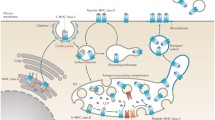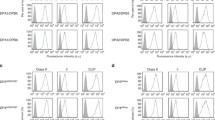Abstract
MHC class II molecules play a pivotal role for the induction and maintenance of immune responses against pathogens, but are also implicated in pathological conditions like autoimmune diseases or rejection of transplanted organs. Human antigen-presenting cells express three human leukocyte antigen (HLA) class II isotypes (DR, DP, and DQ), which are, with the exception of DRα, composed of highly polymorphic α and β subunits. The combination of α- and β-chains results in a multitude of MHC-II αβ-heterodimers of the same isotype, but also isotype-mixed MHC class II molecules have been identified. Invariant chain chaperones the assembly of MHC-II molecules within the endoplasmatic reticulum and also facilitates the intracellular transport to MHC class II loading compartments (MIICs). MHC-II molecules are loaded with antigenic peptides and shuttled to the cell surface for inspection by CD4 T-cells. Alternatively, class-II molecules enriched on intraluminal vesicles can be released via exosomes into the extracellular space. Since some of the αβ-combinations may yield mismatched nonfunctional heterodimers, it is not entirely clear which type of HLA class II peptide receptors are transported to MIICs and found on the cell surface of antigen-presenting cells. We present techniques to inspect assembly, intracellular transport, cell surface expression, and exosomal release of MHC class II heterodimers.
Access this chapter
Tax calculation will be finalised at checkout
Purchases are for personal use only
Similar content being viewed by others
References
Ayala García MA, González Yebra B, López Flores AL, Guaní Guerra E (2012) The major histocompatibility complex in transplantation. J Transp Secur 2012:842141
Piertney SB, Oliver MK (2005) The evolutionary ecology of the major histocompatibility complex. Heredity 96:7
Schooten E, Di Maggio A, van Bergen En Henegouwen PMP, Kijanka MM (2018) MAGE-A antigens as targets for cancer immunotherapy. Cancer Treat Rev 67:54–62
You L, Mao L, Wei J, Jin S, Yang C, Liu H, Zhu L, Qian W (2017) The crosstalk between autophagic and endo-/exosomal pathways in antigen processing for MHC presentation in anticancer T cell immune responses. J Hematol Oncol 10:165
Ermann J, Fathman CG (2001) Autoimmune diseases: genes, bugs and failed regulation. Nat Immunol 2:759
Blander JM (2018) Regulation of the cell biology of antigen cross-presentation. Annu Rev Immunol 36:717–753
Valečka J, Almeida CR, Su B, Pierre P, Gatti E (2018) Autophagy and MHC-restricted antigen presentation. Mol Immunol 99:163–170
Robinson J, Halliwell JA, Hayhurst JD, Flicek P, Parham P, Marsh SG (2014) The IPD and IMGT/HLA database: allele variant databases. Nucleic Acids Res 43:D423–D431
Gotoh Y, Takashima H, Noguchi K, Nishimura H, Tokushima M, Shirai T, Kimoto M (1993) Mixed haplotype A beta Z/A alpha d class II molecule in (NZB x NZW)F1 mice detected by T cell clones. J Immunol 150:4777–4787
Kimoto M (1996) Mixed-haplotype and mixed-isotype major histocompatibility complex class II molecules detected by murine T-cell clones and their possible involvement in autoimmunity. Methods 9:430–438
Koeleman BP, Lie BA, Undlien DE, Dudbridge F, Thorsby E, De Vries RR, Cucca F, Roep BO, Giphart M, Todd JA (2004) Genotype effects and epistasis in type 1 diabetes and HLA-DQ trans dimer associations with disease. Genes Immun 5:381
Malissen B, Shastri N, Pierres M, Hood L (1986) Cotransfer of the Ed alpha and Ad beta genes into L cells results in the surface expression of a functional mixed-isotype Ia molecule. Proc Natl Acad Sci U S A 83:3958–3962
Silk JD, Schoendorf D, Bartok I, Chai J-G, Gray D, Simpson E, Dyson J (2005) Mixed-haplotype MHC class II molecules select functional CD4+ T cells. Mol Immunol 42:1129–1139
Germain RN, Quill H (1986) Unexpected expression of a unique mixed-isotype class II MHC molecule by transfected L-cells. Nature 320:72–75
Lotteau V, Teyton L, Burroughs D, Charron D (1987) A novel HLA class II molecule (DR alpha-DQ beta) created by mismatched isotype pairing. Nature 329:339–341
Ruberti G, Sellins KS, Hill CM, Germain RN, Fathman CG, Livingstone A (1992) Presentation of antigen by mixed isotype class II molecules in normal H-2d mice. J Exp Med 175:157–162
Spencer JS, Kubo RT (1989) Mixed isotype class II antigen expression. A novel class II molecule is expressed on a murine B cell lymphoma. J Exp Med 169:625–640
Temme S, Zacharias M, Neumann J, Wohlfromm S, König A, Temme N, Springer S, Trowsdale J, Koch N (2014) A novel family of human leukocyte antigen class II receptors may have its origin in archaic human species. J Biol Chem 289:639–653
Koch N, Moldenhauer G, Hofmann W, Möller P (1991) Rapid intracellular pathway gives rise to cell surface expression of the MHC class II-associated invariant chain (CD74). J Immunol 147:2643–2651
McCormick PJ, Martina JA, Bonifacino JS (2005) Involvement of clathrin and AP-2 in the trafficking of MHC class II molecules to antigen-processing compartments. Proc Natl Acad Sci 102:7910–7915
Garstka MA, Neefjes J (2013) How to target MHC class II into the MIIC compartment. Mol Immunol 55:162–165
Sadegh-Nasseri S, Chen M, Narayan K, Bouvier M (2008) The convergent roles of tapasin and HLA-DM in antigen presentation. Trends Immunol 29:141–147
Wubbolts R, Neefjes J (1999) Intracellular transport and peptide loading of MHC class II molecules: regulation by chaperones and motors. Immunol Rev 172:189–208
Babbitt BP, Allen PM, Matsueda G, Haber E, Unanue ER (1985) Binding of immunogenic peptides to Ia histocompatibility molecules. Nature 317:359–361
Meldolesi J (2018) Exosomes and ectosomes in intercellular communication. Curr Biol 28:R435–R444. https://doi.org/10.1016/j.cub.2018.01.059
Poe AJ, Knowlton AA (2018) Exosomes and cardiovascular cell–cell communication. Essays Biochem 62:193–204. https://doi.org/10.1042/EBC20170081
Théry C, Duban L, Segura E, Véron P, Lantz O, Amigorena S (2002) Indirect activation of naïve CD4+ T cells by dendritic cell-derived exosomes. Nat Immunol 3:1156–1162
Temme S, Eis-Hübinger AM, McLellan AD, Koch N (2010) The herpes simplex virus-1 encoded glycoprotein B diverts HLA-DR into the exosome pathway. J Immunol 184:236–243
Shackelford DA, Strominger J (1983) Analysis of the oligosaccharides on the HLA-DR and DC1 B cell antigens. J Immunol 130:274–282
Germain RN, Hendrix LR (1991) MHC class II structure, occupancy and surface expression determined by post-endoplasmic reticulum antigen binding. Nature 353:134–139
Mellins E, Smith L, Arp B, Cotner T, Celis E, Pious D (1990) Defective processing and presentation of exogenous antigens in mutants with normal HLA class II genes. Nature 343:71–74
Watanabe M, Suzuki T, Taniguchi M, Shinohara N (1983) Monoclonal anti-Ia murine alloantibodies crossreactive with the Ia-homologues of other mammalian species including humans. Transplantation 36:712–718
Pesando JM, Graf L (1986) Differential expression of HLA-DR, -DQ, and -DP antigens on malignant B cells. J Immunol 136:4311–4318
Temponi M, Kekish U, Hamby CV, Nielsen H, Marboe CC, Ferrone S (1993) Characterization of anti-HLA class II monoclonal antibody LGII-612.14 reacting with formalin fixed tissues. J Immunol Methods 161:239–256
Lampson LA, Levy R (1980) Two populations of Ia-like molecules on a human B cell line. J Immunol 125:293–299
Hitzel C, Grüneberg U, van Ham M, Trowsdale J, Koch N (1999) Sodium dodecyl sulfate-resistant HLA-DR “superdimer” bands are in some cases class II heterodimers bound to antibody. J Immunol 162:4671–4676
Accolla RS, Gross N, Carrel S, Corte G (1981) Distinct forms of both alpha and beta subunits are present in the human Ia molecular pool. Proc Natl Acad Sci U S A 78:4549–4551
Charron D, McDevitt H (1980) Characterization of HLA-D-region antigens by two-dimensional gel electrophoresis. Molecular-genotyping. J Exp Med 152:18s–36s
Adams T, Bodmer J, Bodmer W (1983) Production and characterization of monoclonal antibodies recognizing the alpha-chain subunits of human ia alloantigens. Immunology 50:613
Ting YT, Temme S, Koch N, McLellan AD (2009) A new monoclonal antibody recognizing a linear determinant on the HLA-DRα chain N-terminus. Hybridoma 28:423–429
Spits H, Borst J, Giphart M, Coligan J, Terhorst C, de Vries JE (1984) HLA-DC antigens can serve as recognition elements for human cytotoxic T lymphocytes. Eur J Immunol 14:299–304
Shookster L, Matsuyama T, Burmester G, Winchester R (1987) Monoclonal antibody 1a3 recognizes a monomorphic epitope unique to DQ molecules. Hum Immunol 20:59–70
Wraight CJ, Van Endert P, Möller P, Lipp J, Ling N, MacLennan I, Koch N, Moldenhauer G (1990) Human major histocompatibility complex class II invariant chain is expressed on the cell surface. J Biol Chem 265:5787–5792
Denzin LK, Robbins NF, Carboy-Newcomb C, Cresswell P (1994) Assembly and intracellular transport of HLA-DM and correction of the class II antigen-processing defect in T2 cells. Immunity 1:595–606
Southern JA, Young D, Heaney F, Baumgärtner W, Randall R (1991) Identification of an epitope on the P and V proteins of simian virus 5 that distinguishes between two isolates with different biological characteristics. J Gen Virol 72:1551–1557
Kurth D, Neumann J, Demleitner K, Hildmann J, Mehlig M, Scheicher C, Wendling U, Sun D, Reske K (1997) Full length cDNA of rat RT1. DMa and RT1. DMb and expression of RT1. DM genes in dendritic and Langerhans cells. Biol Chem 378:1005–1012
Neumann J (2005) Novel antibody tags from the rat lysosomal protein RT1. DM for immunodetection of recombinant proteins. J Immunol Methods 301:66–76
Paul P, van den Hoorn T, Jongsma MLM, Bakker MJ, Hengeveld R, Janssen L, Cresswell P, Egan DA, van Ham M, ten Brinke A, Ovaa H, Beijersbergen RL, Kuijl C, Neefjes J (2011) A genome-wide multidimensional RNAi screen reveals pathways controlling MHC class II antigen presentation. Cell 145:268–283
Schindelin J, Arganda-Carreras I, Frise E, Kaynig V, Longair M, Pietzsch T, Preibisch S, Rueden C, Saalfeld S, Schmid B, Tinevez J-Y, White DJ, Hartenstein V, Eliceiri K, Tomancak P, Cardona A (2012) Fiji: an open-source platform for biological-image analysis. Nat Methods 9:676–682
Koch N (1988) Posttranslational modifications of the Ia-associated invariant protein p41 after gene transfer. Biochemistry (Mosc) 27:4097–4102
Kämper N, Franken S, Temme S, Koch S, Bieber T, Koch N (2012) γ-Interferon-regulated chaperone governs human lymphocyte antigen class II expression. FASEB J 26:104–116
Johnson JP, Demmer-Dieckmann M, Meo T, Hadam MR, Riethmüller G (1981) Surface antigens of human melanoma cells defined by monoclonal antibodies. I. Biochemical characterization of two antigens found on cell lines and fresh tumors of diverse tissue origin. Eur J Immunol 11:825–831
Koch N, Zacharias M, König A, Temme S, Neumann J, Springer S (2011) Stoichiometry of HLA class II-invariant chain oligomers. PLoS One 6:e17257
Pearson H (2007) The good, the bad and the ugly. Nature 447:138–140
Bolte S, Cordelières FP (2006) A guided tour into subcellular colocalization analysis in light microscopy. J Microsc 224:213–232
Niazy N*, Temme S*, Bocuk D, Giesen C, Konig A, Temme N, Ziegfeld A, Gregers TF, Bakke O, Lang T, Eis-Hübinger AM, Koch N (2017) Misdirection of endosomal trafficking mediated by herpes simplex virus-encoded glycoprotein B. FASEB J 31:1650–1667
Acknowledgments
We thank Angelika König for expert technical assistance.
Author information
Authors and Affiliations
Corresponding author
Editor information
Editors and Affiliations
Rights and permissions
Copyright information
© 2019 Springer Science+Business Media, LLC, part of Springer Nature
About this protocol
Cite this protocol
Temme, S., Temme, N., Koch, N. (2019). Assembly, Intracellular Transport, and Release of MHC Class II Peptide Receptors. In: van Endert, P. (eds) Antigen Processing. Methods in Molecular Biology, vol 1988. Humana, New York, NY. https://doi.org/10.1007/978-1-4939-9450-2_22
Download citation
DOI: https://doi.org/10.1007/978-1-4939-9450-2_22
Published:
Publisher Name: Humana, New York, NY
Print ISBN: 978-1-4939-9449-6
Online ISBN: 978-1-4939-9450-2
eBook Packages: Springer Protocols




